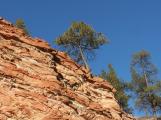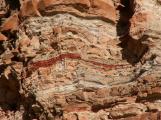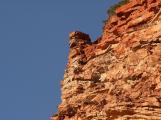1
Pictograph along the Old Hedley Road19 March 2006
Hedley, Similkameen Valley, British Columbia, Canada
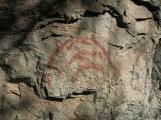
2
Close to the Old Hedley Road, which winds along beside the Similkameen River, remain the last visible traces of the earliest travels recorded in this valley. With stories to be told of hunts and journeys, of tragedy or victory, the cliffs and rocks form a message board to tell of the exploits of those who passed.4
The Similkameens, part of the Interior Salish people group, found in the red ochre cliffs near Princeton an important source of trade with other tribes. Carefully guarded to prevent the discovery of its location, the ochre was mixed and used to paint pictographs down the length of the valley to Keremeos. Some can be found near the highway; others are more inaccessible, following the remnants of old pack trails.6
There is a legend - the legend of Spanish Mound - which tells of the visit of Spaniards, over three hundred years ago. They were said to have spent the winter near Kelowna; in the spring they came through the Similkameen again. Engaging in a battle with the local Indians, they were killed and buried, along with their armour, at the Mound.8
The first official record of a white man passing through the area was that of Alexander Ross, a scout for the North West Fur Company.In 1827, the Similkameen is noted on maps of the Thompson River district, prepared by Factor Archibald MacDonald, who was in charge of the Hudson's Bay Company post at Kamloops.
1859 was the year of an official exploration of the brigade trails by Lieutenant Palmer of the Royal Engineers, accompanied by Angus MacDonald of the HBC.
Governor Sir James Douglas travelled the valley on his tour of inspection to the Rock Creek mines, and Governor-General Earl Grey stopped in Keremeos in 1909 after the completion of the railway.
9
Laughlin "Lockie" Gillanders with a wolfAshnola Valley, British Columbia, Canada
 Credits:
Credits:From the collection of J.W. Barber
10
Long before the time of these latter visitors, the area became essential to the operations of the Hudson's Bay Company. The border commission treaty of 1846 and the measures that followed radically limited the scope of trade south of the 49th parallel; the Similkameen was increasingly used as a trade route connecting brigade trails from the Interior with the Coast.11
Bill Armstrong with packhorses in front of Innis livery barnKeremeos, Similkameen Valley, British Columbia, Canada
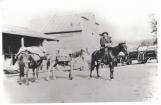 Credits:
Credits:From the Joe Bromley collection
12
In January of 1860, Hudson's Bay Chief Factor William Fraser Tolmie recommended that Fort Okanogan be closed and that the post be moved to British territory. This was done and Francois Deschiquette, the officer from Fort Okanogan, started a post near the present site of Cawston.Unfortunately, the location was not ideal, as the area chosen was swampy, infested with flies and mosquitoes, and moreover, was too far from the Hope-Fort Colville trail. However, it took until the spring or summer of 1866 before the post was moved to Keremeos.
13
The Hudson's Bay Company post, at the site of the Daly RanchWinter 1937
Keremeos, Similkameen Valley, British Columbia, Canada
 Credits:
Credits:Keremeos Museum
14
The post, first known as Shimilkameen, was used for much more than just an outlet for trading. Fur bales from the Interior moved down the Okanagan Brigade Trail to Keremeos, from which centre they were packed out to Hope, sent by riverboat to New Westminster and on to Victoria.The successful continuation of trade was dependent upon good pack animals; Roderick McLean, Deschiquette's successor, saw to the raising of livestock - horses and hardy mules for packing over mountain trails as well as cattle for barter with the natives.
Lieutenant Charles W. Wilson, British Boundary Commission Secretary, wrote in his diary:
"...the finest part of the valley was occupied -- by the Hudson's Bay Company -- (Deschiquette) had some cows and a large number of oxen so that we had a good drink of milk, a thing not to be despised in this part of the world..."
They also grew an abundant supply of vegetables for their own use and for trade. McLean and his assistant, F.X. Richter, pre-empted large portions of land to run this extensive operation.
